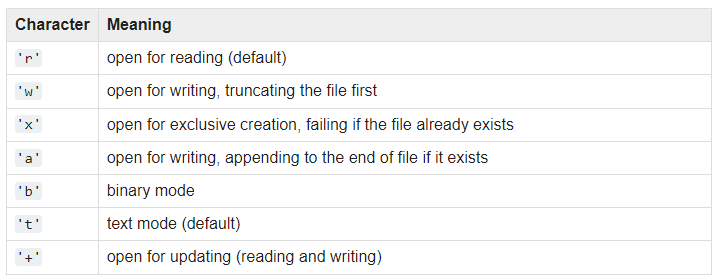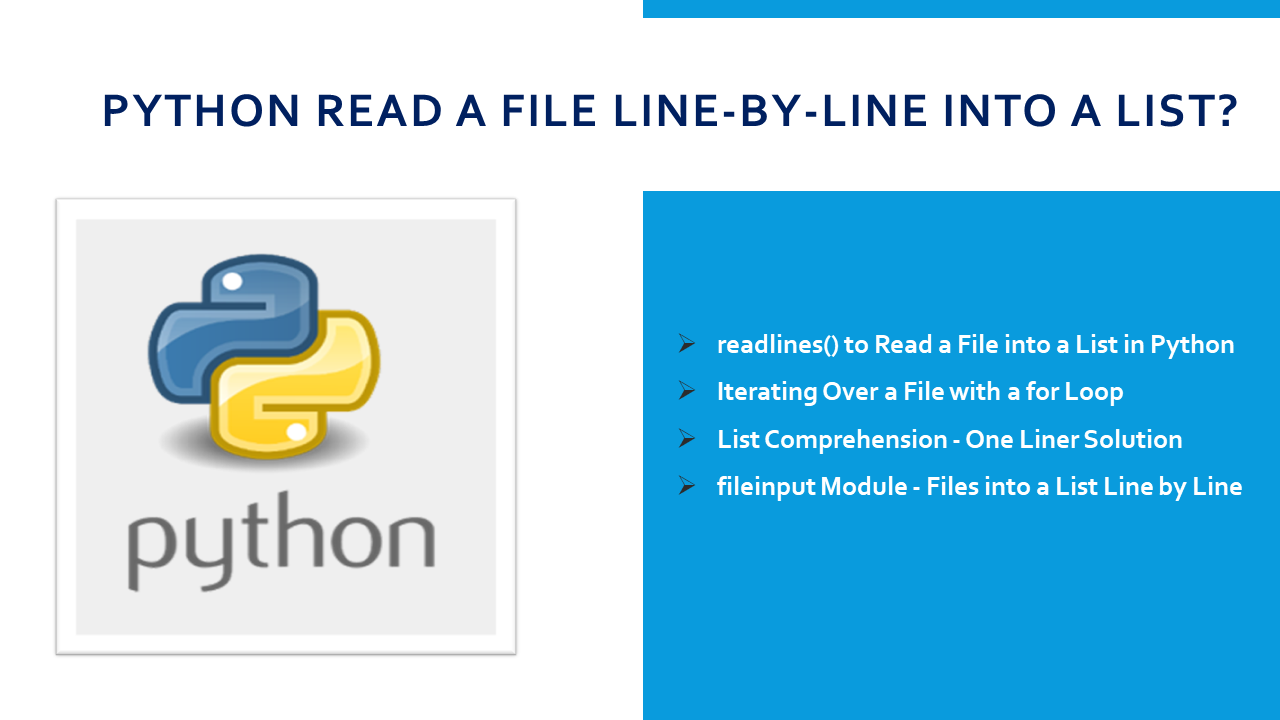Python: Read File Line by Line into List
Learn how to efficiently read a file line by line and store its contents into a list using Python, simplifying file processing for your tasks.
Learn how to efficiently read a file line by line and store its contents into a list using Python, simplifying file processing for your tasks.
In this article, we'll explore different ways to read a file line by line and store the lines in a list using Python. We'll cover two main methods: using the readlines() method and iterating through the file with a for loop.
To read a file line by line into a list in Python, you can use several methods. One common approach is using the readlines() method:
Open the file: Use the open() function with the file name and mode as arguments. For reading, use mode 'r'.
file = open("your_file.txt", 'r')Read lines into a list: Call the readlines() method on the file object. This reads all lines and stores them as strings in a list.
lines = file.readlines()(Optional) Remove newline characters: Each line from readlines() usually ends with a newline character (\n). You can remove them using strip().
lines = [line.strip() for line in lines] Close the file: It's important to close the file after you're done to free up resources.
file.close()Alternatively, you can use a for loop for more memory-efficient processing, especially with large files:
Open the file using with open(): This ensures the file is automatically closed even if errors occur.
with open("your_file.txt", 'r') as file:Iterate through lines: Use a for loop to read and process each line individually.
for line in file:
# Process each line hereRemember to replace "your_file.txt" with the actual name of your file.
The Python code demonstrates two methods for reading a text file line by line. The first method reads all lines into a list using readlines(), while the second method iterates through each line using a for loop. Both methods remove newline characters from each line and either print the lines or allow for further processing. The second method is generally more memory-efficient, especially for large files.
# Method 1: Using readlines()
# Open the file for reading
file = open("my_file.txt", 'r')
# Read all lines into a list
lines = file.readlines()
# Remove newline characters from each line
lines = [line.strip() for line in lines]
# Print the list of lines
print(lines)
# Close the file
file.close()
# ---
# Method 2: Using a for loop (more memory-efficient)
# Open the file for reading using 'with open()'
with open("my_file.txt", 'r') as file:
# Iterate through each line in the file
for line in file:
# Process each line here (e.g., print it)
print(line.strip()) Example file (my_file.txt):
This is the first line.
This is the second line.
And this is the third line.
Output (both methods):
['This is the first line.', 'This is the second line.', 'And this is the third line.']
Explanation:
Both methods achieve the same result of reading the file line by line and storing the lines in a list (or processing them directly in Method 2). Choose the method that best suits your needs and file size.
Clarifications and Considerations:
"your_file.txt". Make sure to provide the correct relative or absolute path to your file if it's not in the same directory as your Python script.encoding='utf-8') to handle different character sets correctly.try-except blocks to gracefully handle situations like the file not being found (FileNotFoundError).Beyond the Basics:
readline() Method: You can also read a file line by line using the readline() method, which reads one line at a time. This is useful if you want more control over the reading process or if you're dealing with very large files.sys.stdin) or network sockets.Choosing the Right Method:
readlines(): Suitable for small to medium-sized files where you need all lines in memory for processing.for loop: More memory-efficient for large files, as it processes one line at a time.Example Use Cases:
This article explains two ways to read a file line by line in Python and store the lines in a list:
Method 1: Using readlines()
file = open("your_file.txt", 'r')
lines = file.readlines()
lines = [line.strip() for line in lines]
file.close()
Method 2: Using a for loop (more memory-efficient)
with open("your_file.txt", 'r') as file:
for line in file:
# Process each line hereKey Points:
"your_file.txt" with your actual file name.readlines() reads all lines at once, which can be memory-intensive for large files.for loop processes one line at a time, making it more memory-efficient.with open() ensures the file is always closed properly.In conclusion, reading files line by line in Python is a fundamental operation for various tasks. Whether you choose to use readlines() for smaller files or iterate through the file object with a for loop for larger datasets, Python provides straightforward methods to achieve this. Understanding the nuances of each approach, such as memory management and efficiency, will enable you to select the most suitable technique for your specific file-handling needs. By mastering these techniques, you'll be well-equipped to handle file input effectively in your Python programs.
 Python Program Read a File Line by Line Into a List | Example 1: Using readlines() · First, open the file and read the file using readlines() . · If you want to remove the new lines (' \n '), you can use strip().
Python Program Read a File Line by Line Into a List | Example 1: Using readlines() · First, open the file and read the file using readlines() . · If you want to remove the new lines (' \n '), you can use strip(). Read a file line by line in Python - GeeksforGeeks | A Computer Science portal for geeks. It contains well written, well thought and well explained computer science and programming articles, quizzes and practice/competitive programming/company interview Questions.
Read a file line by line in Python - GeeksforGeeks | A Computer Science portal for geeks. It contains well written, well thought and well explained computer science and programming articles, quizzes and practice/competitive programming/company interview Questions. Here is how to read a file line-by-line into a list in Python | To read a file line-by-line into a list in Python, you can use the readlines() method of the file object. Alternatively, you can also use a for loop.
Here is how to read a file line-by-line into a list in Python | To read a file line-by-line into a list in Python, you can use the readlines() method of the file object. Alternatively, you can also use a for loop. How to read a file line by line into a list in Python | by ... | Introduction
How to read a file line by line into a list in Python | by ... | Introduction How to read the file and make a list - Questions / Help - Elixir ... | I read my file in Elixir with the following code It takes a long time to read the file File.stream!("big.txt") |> Enum.map(&String.trim/1) But in Python, I read the file in the fastest possible way with the following code [line.rstrip() for line in open("big.txt")] Do you have a better offer? Thanks
How to read the file and make a list - Questions / Help - Elixir ... | I read my file in Elixir with the following code It takes a long time to read the file File.stream!("big.txt") |> Enum.map(&String.trim/1) But in Python, I read the file in the fastest possible way with the following code [line.rstrip() for line in open("big.txt")] Do you have a better offer? Thanks Python Read a File line-by-line into a List? - Spark By {Examples} | Python How to read a file line-by-line into a list? There are several different methods you can use to read a file line-by-line into a list in Python. In
Python Read a File line-by-line into a List? - Spark By {Examples} | Python How to read a file line-by-line into a list? There are several different methods you can use to read a file line-by-line into a list in Python. In Sorry, False Alarm. Should 'for line in m.readlines():' be the same as ... | Should these two code fragments have identical results? They do not. m is a file handle for a file in a zip archive. The first requires me to use decode to change line to a string. The second sometimes converts input to a string requiring me to check that it is not a string before using decode. for line in m.readlines() lines = m.readlines() for line in lines:
Sorry, False Alarm. Should 'for line in m.readlines():' be the same as ... | Should these two code fragments have identical results? They do not. m is a file handle for a file in a zip archive. The first requires me to use decode to change line to a string. The second sometimes converts input to a string requiring me to check that it is not a string before using decode. for line in m.readlines() lines = m.readlines() for line in lines: